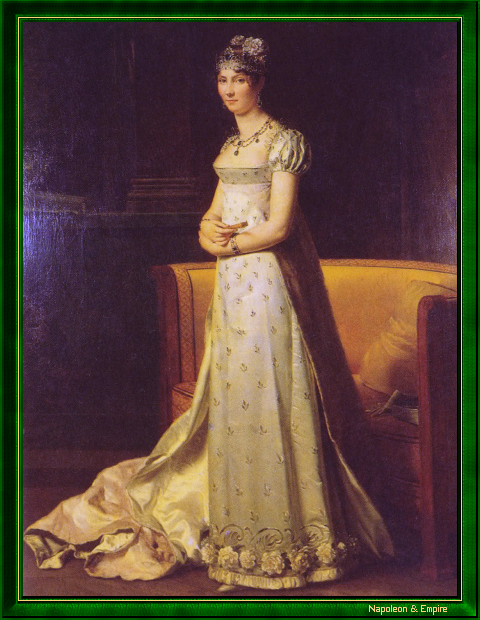Stephanie de Beauharnais
Grand duchess of Baden
Pronunciation:

Stéphanie de Beauharnais was the daughter of Count Claude de Beauharnais, elder brother of Viscount Alexandre François Marie de Beauharnais, first husband of Marie-Josèphe-Rose de Tascher de la Pagerie. Stéphanie was therefore the niece of the future Empress and first cousin of Eugène de Beauharnais and his sister Hortense.
She was born in Versailles on August 28, 1789. Two years later, after the death of her mother, Madame de Lezay-Marnesia, she was abandoned by her father and taken in by a wealthy Englishwoman who adopted her and had her placed in a convent in the south of France. Napoleon, having learned of her existence from Joséphine in 1802, ordered her return to Paris and entrusted her education to the famous Madame Campan (Jeanne-Louise-Henriette by her first name), who had already seen Caroline and Pauline Bonaparte, as well as Hortense de Beauharnais, pass through her boarding school.
In 1806, the Emperor adopted Stéphanie, making her an imperial princess, and shortly afterwards gave her in marriage to the Crown Prince of Baden, who had just been stripped of his fiancée, Augusta of Bavaria, in favor of Eugène de Beauharnais. The ceremony took place with great pomp at the Tuileries, on April 8 of that year, according to the Catholic rite (although it was agreed that future children would be raised in the Protestant faith).
At first, the union was not a happy one, as the prince, a notorious debauchee, showed little interest in his young bride. Eventually, however, things settled down enough for the couple to conceive five children, though unfortunately without producing an heir.
Stephanie became Grand Duchess in 1811, when her husband ascended the throne of Baden. But the Grand Duke died prematurely in December 1818, leaving her isolated in the face of those who, a few years earlier, at the fall of the Empire, had unsuccessfully demanded her husband's repudiation, which the absence of a Protestant marriage made easy.
The dowager Grand Duchess - she was twenty-nine years old - settled in Mannheim and led a life that eventually disarmed the prejudices of European sovereigns against what she represented. Tsar Alexander I and the King of Bavaria, husbands of her sisters-in-law Louise-Augusta and Caroline de Bade, became true friends.
She led a peaceful life, devoting herself to the education and marriage of her daughters. She returned to France after the accession of Napoleon III, and had the pleasure of attending the christening of the Prince Imperial in 1856.
Stéphanie died in Nice on January 29, 1860.
"Stephanie de Beauharnais", painted by François Pascal Simon Gerard (Rome 1770 - Paris 1837).

Her first son, who died officially at less than a month old on October 16, 1812, has sometimes been identified with the famous Kaspar Hauser, who appeared in Nuremberg in 1828. The theory that the young prince had been kidnapped and replaced by the child who died on October 16 was very popular at the time, and remained so even after Kaspar's death in 1833. It is still supported today, and contradictory DNA analyses do not allow us to conclude with certainty whether it is true or false. Stephanie's personal feelings on the subject remain unknown, as many of her writings disappeared after her death.
In 2004, the Post Office of Monaco issued a 1.90 EUR stamp bearing the effigy of Stéphanie de Beauharnais, since she is the grandmother of Prince Albert II (as well as the King of the Belgians and the Grand Duke of Luxembourg).
Other portraits

"Stephanie de Beauharnais". Anonymous, XIXth century.

"Stephanie de Beauharnais". Anonymous, XIXth century.